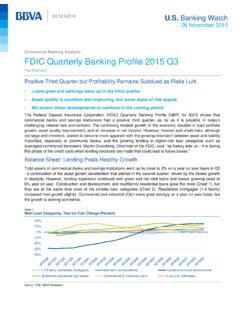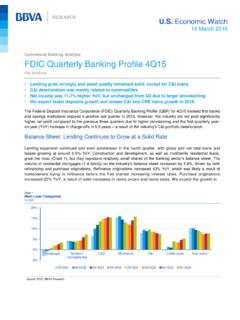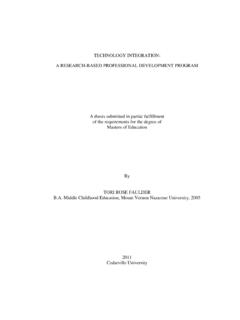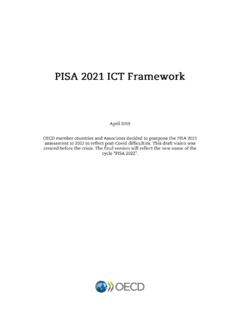Transcription of Importance of ICT in society’s needs
1 Financial Inclusion Document / August 2017 1 DIGITAL ECONOMY The Importance of ICT in society s needs : An empirical approach through Maslow s lens1 Alfonso Arellano / Noelia C mara August 2017 The aim of the Watch is to point out the Importance of ICT in developing and emerging countries from a demand-side perspective. We find that having a cell phone and internet access are gaining Importance among individuals basic needs . Younger people consider ICT-related needs more basic than older people do. In addition, economic development matters when technology is not widely implemented. 1. Introduction The development of Information and Communication Technologies (ICT) has strong potential to transform economies and societies in several ways, such as reducing information and transaction costs, creating new collaborative models to increase the efficiency of workers, promoting innovation, and improving education and access to basic services.
2 Innovation seems to be everywhere in the lives of consumers, in industry and service production processes, as well as in public sector tasks. However, while we observe dramatic changes in people's lives, it is difficult to find any effect in productivity statistics. The same happened when computers were brought into society massively (Griliches, 1994; Brynjolfsson and Yang, 1996; Triplett, 1999; and Jorgenson, 2001) and this phenomenon, known as the Solow Paradox (1987), had already been observed in the boost from information technology. Researchers argue about why macroeconomic statistics are not showing increases in productivity that point to a new industrial revolution.
3 Our hypothesis is that the effects of the current revolution on the economy might be reflected more on the demand-side rather than the supply-side. In addition to the arguments of mismeasurement of GDP growth and weak investment since the financial crisis, the impact of the digital economy is hard to measure using traditional indicators from the supply-side, such as productivity Most of the welfare gain from digital services on the internet is overlooked by traditional approaches, which only rely on monetary expenditure. The current system of GDP accounting has rigidities when it comes to free services.
4 If a service lacks a price, then there is no standard way to estimate its worth in terms of money. However, consequences associated with ICT affect not only the productivity of individuals as workers (labour suppliers), but also as consumers by changing their welfare levels ( demand for goods and services and quality of life). With smartphones and free apps everywhere, there are so many 1: We thank Hicham Ganga for his comments and assistance. 2: Although some effects should appear, the way to measure this is not clear yet, partly due to the mis-measurement hypothesis (Feldstein, 2015, and Davies, 2016).
5 Financial Inclusion Document / August 2017 2 free services, which create problems for the GDP We argue that the effects of this revolution might be reflected in the demand-side more than in the supply-side. It does not matter how important the services are, nor how much they have improved over time. Any improvement in the quality of search services is not a contribution to GDP because this is a measure of total production and not of a society's welfare. In order to capture the economic magnitude of current innovations, we suggest focussing on demand-side measures for free goods, such as the consumer welfare derived from internet services that reflects qualitative improvement in user experiences.
6 Given the substantial fluctuations in medium-term Total Factor Productivity (TFP) growth and the likelihood that forecasts are confounded, it would not be surprising if revisions to expectations about future productivity growth are a source of significant aggregate-demand shocks (Crafts and Mills, 2017 ). Many of the tasks that individuals perform on a regular basis, such as thinking about what to buy (recommender systems), asking for health advice, booking a trip or paying taxes, are carried out in a dramatically different manner using internet applications. However, how to measure the impact of these elements in terms of productivity and its relationship with GDP is still In order to test for this mechanism, this study focuses on the demand-side from the point of view of the individual as a consumer and analyses the relative position of two indicators that relate to the digital economy (having Internet access and owning a cell phone) in the context of consumer needs for 34 developing countries.
7 We rely on microdata from the Pew Research Center in 2014 to shed some light on the welfare impact of ICT in society by scaling to a country-level perspective Alonso and Arellano (2015) and Arellano and Garc a ( 2017 ) find a differentiated ICT adoption pattern between younger consumers (associated with the term digital natives ) and older consumers ( digital immigrants ) in developed countries like Spain. Thus, in order to test for the existence of this pattern in developing countries, we carry out an analysis based on different age-groups of consumers. The rest of the paper is organized as follows.
8 Section 2 shows how Internet and cell phone usage fit into Maslow s pyramid and explores the evidence across countries of the Importance of technology adoption in these societies according to age. Section 3 analyses the relationship between ICT needs and economic development. Section 4 concludes. 3: Free consumer entertainment and information from the internet, largely supported by advertising revenues, has had a major impact on consumer behavior. Some economists believe that measured gross domestic product (GDP) growth is badly underestimated because GDP excludes online entertainment (Brynjolfsson and Oh, 2012; Greenstein, 2017 ; Ito, 2013; Aeppel, 2015;and Nakamura et al.)
9 , 2016) 4: From a historical perspective, the relationship between estimated trends in total factor productivity growth and subsequent outcomes does not appear to be a good indicator (Crafts and Mills, 2017 ). They show that by looking at American trend TFP growth in the business sector, one would have missed all the major episodes from 1967 to 2016. It argues that in the past, trend growth estimates have not been a good guide to future medium-term outcomes, and techno-optimists should not be put off by time-series econometrics. Also, Gordon (2016) shows that the burst of productivity growth between 1994 and 2014 (often attributed to the internet) has ended in a period of extremely low productivity growth.
10 Financial Inclusion Document / August 2017 3 2. The role of internet in society through Maslow s lens The idea of relative utility was presented by Maslow (1943) when defining his theory of human motivation using a list of the basic needs of adults. Using a pyramid structure, the base comprises physiological needs , those relating to homeostasis and preferential choices among foods. Once physiological needs are satisfied, safety needs come to the fore. Safety needs relate to emergencies and disorder levels in the context of the individual (family / society). A third level refers to needs associated with love, affection and belongingness.










